Standards Worldwide
Standards Worldwide
Phone +49 30 58885700-07

Standard [CURRENT]
ASTM D 5185:2018
Standard Test Method for Multielement Determination of Used and Unused Lubricating Oils and Base Oils by Inductively Coupled Plasma Atomic Emission Spectrometry (ICP-AES)
- Publication date
- 2018
- Original language
- English
- Pages
- 9
- Publication date
- 2018
- Original language
- English
- Pages
- 9
- DOI
- https://dx.doi.org/10.1520/D5185-18
Product information on this site:
Quick delivery via download or delivery service
Buy securely with a credit card or pay upon receipt of invoice
All transactions are encrypted
Short description
1.1 This test method covers the determination of additive elements, wear metals, and contaminants in used and unused lubricating oils and base oils by inductively coupled plasma atomic emission spectrometry (ICP-AES). The specific elements are listed in Table 1 . (A) These wavelengths are only suggested and do not represent all possible choices. 1.2 This test method covers the determination of selected elements, listed in Table 1 , in re-refined and virgin base oils. 1.3 For analysis of any element using wavelengths below 190nm, a vacuum or inert-gas optical path is required. The determination of sodium and potassium is not possible on some instruments having a limited spectral range. 1.4 This test method uses oil-soluble metals for calibration and does not purport to quantitatively determine insoluble particulates. Analytical results are particle size dependent, and low results are obtained for particles larger than a few micrometers. 2 1.5 Elements present at concentrations above the upper limit of the calibration curves can be determined with additional, appropriate dilutions and with no degradation of precision. 1.6 For elements other than calcium, sulfur, and zinc, the low limits listed in Table 2 and Table 3 were estimated to be ten times the repeatability standard deviation. For calcium, sulfur, and zinc, the low limits represent the lowest concentrations tested in the interlaboratory study. (A) where: X =mean concentration, µg/g. (A) where: X =mean concentration, µg/g. 1.7 The values stated in SI units are to be regarded as standard. No other units of measurement are included in this standard. 1.8 This standard does not purport to address all of the safety concerns, if any, associated with its use. It is the responsibility of the user of this standard to establish appropriate safety, health, and environmental practices and determine the applicability of regulatory limitations prior to use. Specific warning statements are given in 6.1 , 8.2 , and 8.4 . 1.9 This international standard was developed in accordance with internationally recognized principles on standardization established in the Decision on Principles for the Development of International Standards, Guides and Recommendations issued by the World Trade Organization Technical Barriers to Trade (TBT) Committee.
ICS
71.040.50,
75.100
DOI
https://dx.doi.org/10.1520/D5185-18
Also available in
Loading recommended items...
Loading recommended items...
Loading recommended items...
Loading recommended items...
